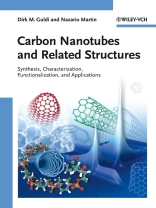Written by the most prominent experts and pioneers in the field, this ready reference combines fundamental research, recent breakthroughs and real-life applications in one well-organized treatise.
As such, both newcomers and established researchers will find here a wide range of current methods for producing and characterizing carbon nanotubes using imaging as well as spectroscopic techniques. One major part of this thorough overview is devoted to the controlled chemical functionalization of carbon nanotubes, covering intriguing applications in photovoltaics, organic electronics and materials design. The latest research on novel carbon-derived structures, such as graphene, nanoonions and carbon pea pods, round off the book.
As such, both newcomers and established researchers will find here a wide range of current methods for producing and characterizing carbon nanotubes using imaging as well as spectroscopic techniques. One major part of this thorough overview is devoted to the controlled chemical functionalization of carbon nanotubes, covering intriguing applications in photovoltaics, organic electronics and materials design. The latest research on novel carbon-derived structures, such as graphene, nanoonions and carbon pea pods, round off the book.
Inhaltsverzeichnis
CARBON NANOTUBES AND RELATED STRUCTURES: PRODUCTION AND FORMATIONIntroduction
Carbon Nanotube Production
Catalysts
Growth Enhancement
Growth Mechanisms
Functionalization
Purification
Futures Perspectives
THEORY OF ELECTRONIC AND OPTICAL PROPERTIES OF DNA-SWNT HYBRIDS
Introduction
Physical Structure and Bonding in Nanotube-DNA Hybrids: A Short Review
Quantum Mechanical Modeling of the Hybrid Structure: Tight Binding Band Structure Calculation
Self-Consistent Computation Scheme: Acting Potential
Screening Factor and the Dielectric Permittivity
Polarization Component of Cohesion Energy of the SWNT-ss DNA Hybrid
Optical Absorption of SWNT-DNA Hybrids
Summary
ELECTROCHEMISTRY
Introduction
Electronic Properties of SWNTs
Electrode Potentials Versus Work Functions
Electrochemistry at SWNTs Versus Electrochemistry of SWNTs
Carbon Nanotubes for Electrochemical Sensors and Biosensors
Electrochemistry of Carbon Nanotubes
Cyclic Voltammetric Investigations of Solutions of Individual SWNTs
Vis-NIR Spectroelectrochemical Investigation of True Solutions of Unfunctionalized SWNTs
Standard Redox Potentials of Individual SWNTs in Solution
Fermi Level and Excitonic Binding Energy of the Nanotubes
Conclusions and Perspectives
PHOTOPHYSICS
Introduction
Molecular Nanoparticles: Carbon Nanotubes Have it All
Understanding Optical Properties
The Coulomb Interaction and Bound States
Colloidal Chemistry Facilitates Detailed Study of Nanotube Optics
Excited State Dynamics and Nonlinear Optics
Outlook
NONCOVALENT FUNCTIONALIZATION OF CARBON NANOTUBES
Introduction
Early Insights in the Noncovalent Interaction of CNTs with Solvents and Classical Macrocyclic Scaffolds
Noncovalent Interactions of CNTs with Small Aromatic Molecules
Noncovalent Interactions of CNTs with Heterocyclic Polyaromatic Systems
Noncovalent Interactions of CNTs with Surfactants and Ionic Liquids
Noncovalent Interactions of CNTs with Polymers
Optically Active SWCNTS
Noncovalent Interactions of CNTs with Nanoparticles
Summary and Conclusions
COVALENT FUNCTIONALIZATION OF CARBON NANOTUBES
Introduction
Chemical Functionalization of Carbon Nanotubes
Defect Group Functionalization of Carbon Nanotubes
Direct Sidewall Functionalization of Carbon Nanotubes
Conclusions
CARBON-BASED NANOMATERIAL APPLICATIONS IN BIOMEDICINE
Introduction
Carbon Nanotubes
Carbon Nanohorns
Carbon Nanodiamonds
Conclusions
GROUND AND EXCITED STATE CHARGE TRANSFER AND ITS IMPLICATIONS
Introduction
Ground and Excited State Features
Ground State Charge Transfer – CNT as Electron Acceptors
Ground State Charge Transfer – CNT as Electron Donors
Excited State Charge Transfer – CNT as Excited State Electron Acceptor
Excited State Charge Transfer – CNT as Ground State Electron Acceptor
Excited State Charge Transfer – CNT as Ground State Electron Donor
Implications of Ground State Charge Transfer
Implications of Excited State Charge Transfer
PHOTOVOLTAIC DEVICES BASED ON CARBON NANOTUBES AND RELATED STRUCTURES
Introduction
Photovoltaic Cells Based on Carbon Nanotubes
Related Structures
Future Directions
LAYER-BY-LAYER ASSEMBLY OF MULTIFUNCTIONAL CARBON NANOTUBE THIN FILMS
Introduction
Structure and Properties of CNTs
Structural Organization in Multilayers of Carbon Nanotubes
Electrical Conductor Applications
Sensor Applications
Fuel Cell Applications
Nano-/Microshell LBL Coatings and Biomedical Applications
Conclusions
CARBON NANOTUBES FOR CATALYTIC APPLICATIONS
Introduction
Macroscopic shaping of CNTs
Specific Metal-Support Interaction
Dispersion of the Active Phase
Electrically and Thermally Conductive Supports
Mass Transfer Limitations
Confinement Effect
Conclusions
CARBON NANOTUBES AS CONTAINERS
Introduction
Mechanisms of Nanotube Filling
Fullerenes as Guest Molecules
Other Types of Molecules
Ionic Compounds
Nnaoparticles in Nanotubes
Concluding Remarks
CARBON NANOHORN
Introduction
Production
Structure and Growth Mechanism
Properties
Functionalization
Toxicity
Drug Delivery Applications
Summary
SELF-ORGANIZATION OF NANOGRAPHE
Über den Autor
Dirk M. Guldi completed both his undergraduate studies (1988) and Ph D (1990) at the University of Cologne (Germany). Following postdoctoral appointments at the National Institute of Standards and Technology (USA), the Hahn-Meitner Institute Berlin (1992), and Syracuse University, he joined the faculty of the Notre Dame Radiation Laboratory in 1995.He was promoted a year later from assistant to associate professional specialist, and remained affiliated to Notre Dame until 2004. Since 2004, he is Full Professor in the Department of Chemistry and Pharmacy at the Friedrich-Alexander-University in Erlangen. His research interests focus on the fundamental structural and electronic requirements for ultrafast charge transport and optical gating in carbon nanostructure arrays of donor-acceptor ensembles and in nanostructured thin films to address issues that correspond to the optimization and fine-tuning of dynamics and/or efficiencies of solar energy conversion.
Nazario Martín is full professor of Organic Chemistry at the University Complutense of Madrid. His research interests span a range of targets with emphasis on the chemistry of carbon nanostructures involving fullerenes and carbon nanotubes, pi-conjugated systems as molecular wires, and Electroactive molecules, in the context of electron transfer processes, photovoltaic applications and nanoscience. He is currently a member of the Editorial Board of Chemical Communications, and the Regional Editor for Europe of the journal Fullerenes, Nanotubes and Carbon Nanostructures. He has received the Du Pont Award for Science in 2007. He is a fellow of The Royal Society of Chemistry, vice-director of IMDEA – Nanoscience Institute, and the President of the Spanish Royal Society of Chemistry.
Sprache Englisch ● Format PDF ● Seiten 540 ● ISBN 9783527629947 ● Dateigröße 12.9 MB ● Herausgeber Dirk M. Guldi & Nazario Martín ● Verlag Wiley-VCH ● Erscheinungsjahr 2010 ● Ausgabe 1 ● herunterladbar 24 Monate ● Währung EUR ● ID 2441358 ● Kopierschutz Adobe DRM
erfordert DRM-fähige Lesetechnologie












